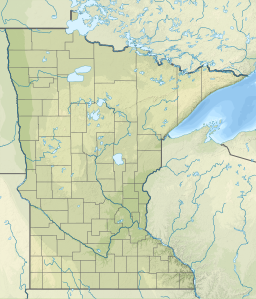
Nicollet County is a county in the U.S. state of Minnesota. As of the 2020 census, the population was 34,454. Its county seat is St. Peter.

Le Sueur County is a county located in the south central portion of the U.S. state of Minnesota. As of the 2020 census, the population was 28,674. Its county seat is Le Center.
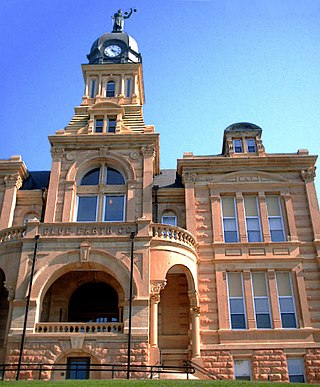
Blue Earth County is a county in the State of Minnesota. As of the 2020 census, the population was 69,112. Its county seat is Mankato. The county is named for the Blue Earth River and for the deposits of blue-green clay once evident along the banks of the Blue Earth River. Blue Earth County is part of the Mankato-North Mankato metropolitan area.
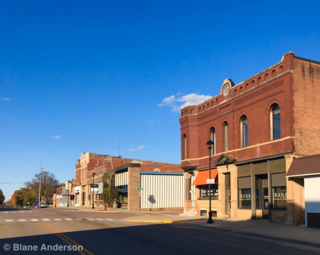
Lake Crystal is a city in Blue Earth County, Minnesota, United States, established in 1869. The population was 2,539 at the 2020 census. It is part of the Mankato-North Mankato Metropolitan Statistical Area.

Waseca is a city in Waseca County, Minnesota, United States. The population was 9,229 at the 2020 census. It is the county seat.
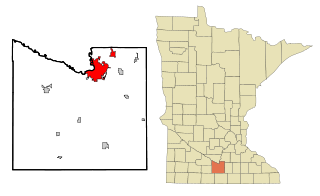
Mankato is a city in Blue Earth, Nicollet, and Le Sueur counties in the U.S. state of Minnesota. It is the county seat of Blue Earth County, Minnesota. The population was 44,488 at the 2020 census, making it the 21st-largest city in Minnesota, and the 4th-largest outside of the Minneapolis–Saint Paul metropolitan area. It is along a large bend of the Minnesota River at its confluence with the Blue Earth River. Mankato is across the Minnesota River from North Mankato. Mankato and North Mankato have a combined population of 58,763 according to the 2020 census. It completely encompasses the town of Skyline. North of Mankato Regional Airport, a tiny non-contiguous part of the city lies within Le Sueur County. Most of the city is in Blue Earth County.

Minnesota State University, Mankato is a public university in Mankato, Minnesota, United States. It is Minnesota's second-largest university and has over 145,000 living alumni worldwide. Founded in 1868, it is the second-oldest member of the Minnesota State Colleges and Universities system and is commonly referred to as the flagship institution. It was established as the Second State Normal School in 1858 and officially opened as Mankato Normal School a decade later. Minnesota State University, Mankato is a significant contributor to the local and state economies, adding $827 million annually.

Savanna Portage State Park is a state park in the U.S. State of Minnesota established in 1961 to preserve the historic Savanna Portage, a difficult 6-mile (9.7 km) trail connecting the watersheds of the Mississippi River and Lake Superior. The portage trail crosses a drainage divide separating the West Savanna River, which drains to the Mississippi River and the Gulf of Mexico, from the East Savanna River, which flows in an opposite direction to the Saint Louis River, Lake Superior and the Great Lakes, and the Saint Lawrence River to the Atlantic Ocean.

Minneopa State Park is a state park in the U.S. state of Minnesota. It was established in 1905 to preserve Minneopa Falls, a large waterfall for southern Minnesota, and was expanded in the 1960s to include the lower reaches of Minneopa Creek and a large tract of prairie. Minneopa is Minnesota's third oldest state park, after Itasca and Interstate. Two park resources are listed on the National Register of Historic Places: the 1862 Seppman Mill and a district of seven Rustic Style structures built by the Works Progress Administration in the late 1930s. The park is located almost entirely on the south side of the Minnesota River, three miles (4.8 km) west of Mankato. In 2015, the state reintroduced American bison to the park in a 330-acre (130 ha) fenced enclosure, through which visitors can drive in their vehicles.
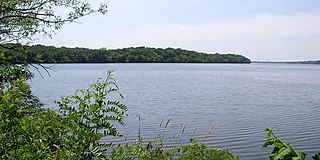
Sakatah Lake State Park is an 842-acre (341 ha) state park of Minnesota, USA, on a natural widening of the Cannon River near the town of Waterville. The Dakota native to the area called it "Sakatah" which means "singing hills". To honor this native heritage, some of the trails in the park have been given Dakota names. The Sakatah Singing Hills State Trail, which connects Faribault and Mankato, runs through this park.
Sports in Minnesota include professional teams in all major sports, Olympic Games contenders and medalists, especially in the Winter Olympics, collegiate teams in major and small-school conferences and associations and active amateur teams and individual sports. The State of Minnesota has a team in all five major professional leagues. Along with professional sports, there are numerous collegiate teams including the University of Minnesota Golden Gophers and St. Thomas Tommies in NCAA Division I, as well as many others across the Minnesota public and private colleges and universities.
ISG Field is a stadium in Mankato, Minnesota, United States, with a capacity of 2,200. It is primarily used for baseball, and is the home field of the Mankato Moondogs of the Northwoods League, a collegiate summer baseball league. Bethany Lutheran College, Mankato West High School, Loyola Catholic School, and Mankato Area Youth Baseball Association also use the venue.
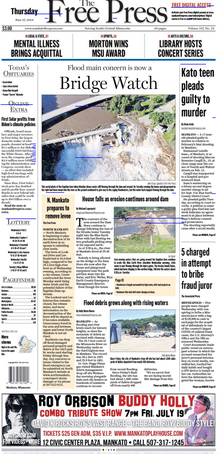
The Free Press is an American, English language daily newspaper published in Mankato, Minnesota.

The Dakota War of 1862, also known as the Sioux Uprising, the Dakota Uprising, the Sioux Outbreak of 1862, the Dakota Conflict, or Little Crow's War, was an armed conflict between the United States and several eastern bands of Dakota collectively known as the Santee Sioux. It began on August 18, 1862, when the Dakota, who were facing starvation and displacement, attacked white settlements at the Lower Sioux Agency along the Minnesota River valley in southwest Minnesota. The war lasted for five weeks and resulted in the deaths of hundreds of settlers and the displacement of thousands more. In the aftermath, the Dakota people were exiled from their homelands, forcibly sent to reservations in the Dakotas and Nebraska, and the State of Minnesota confiscated and sold all their remaining land in the state. The war also ended with the largest mass execution in United States history with the hanging of 38 Dakota men.

Kern Bridge or Yaeger Bridge crossed the Le Sueur River in Blue Earth County in the U.S. state of Minnesota. It was built in 1873 using a bowstring through truss design by the Wrought Iron Bridge Company. It was 183.5 feet (56 m) long and carried a local road. It was listed on the National Register of Historic Places in 1980 as Minnesota's only bowstring arch truss bridge and oldest road bridge still in use. However, it was closed to vehicle traffic in 1991.

This is a list of the National Register of Historic Places listings in Blue Earth County, Minnesota. It is intended to be a complete list of the properties and districts on the National Register of Historic Places in Blue Earth County, Minnesota, United States. The locations of National Register properties and districts for which the latitude and longitude coordinates are included below, may be seen in an online map.
John Eaton Tourtellotte was an American Union brevet brigadier general during the period of the American Civil War. He received his appointment as brevet brigadier general dated to March 13, 1865.

Civil unrest over the murder of George Floyd began as local protests in Minneapolis–Saint Paul on May 26, 2020, the day after George Floyd was killed by a Minneapolis police officer. Protests and civil disorder quickly spread to other locations in the U.S. state of Minnesota, the United States, and internationally. This list includes notable protests and events of civil disorder in Minnesota in the aftermath of George Floyd's murder.
Madison Lake is a lake in Blue Earth County, Minnesota, United States. The lake covers an area of 1,446 acres (5.85 km2) and is 59 feet (18 m) deep at its deepest point. It is named after President James Madison The city of Madison Lake, Minnesota is located on the Northwest shoreline of the lake. The lake and the Point Pleasant resort have been long-noted fishing destinations. Madison Lake is part of the Le Sueur River watershed.
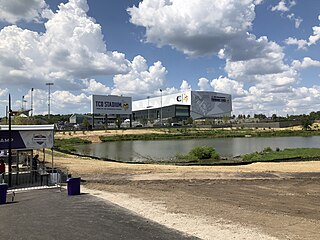
Twin Cities Orthopedics Performance Center is a 40-acre sports complex located in Eagan, Minnesota. Its main use is as the Minnesota Vikings' headquarters and practice facility. The facility includes a 6,000-seat outdoor stadium known as TCO Stadium, in addition to a fully-enclosed indoor practice field and several outdoor natural and synthetic turf practice fields. TCO Performance Center also features player position meeting rooms and team auditorium; expanded locker room, weight room and equipment facilities. Along with state of the art cardiovascular and specialized speed rooms, a hydrotherapy room, and post-workout recovery rooms; a broadcast studio and media center; and administrative offices for Vikings staff.

